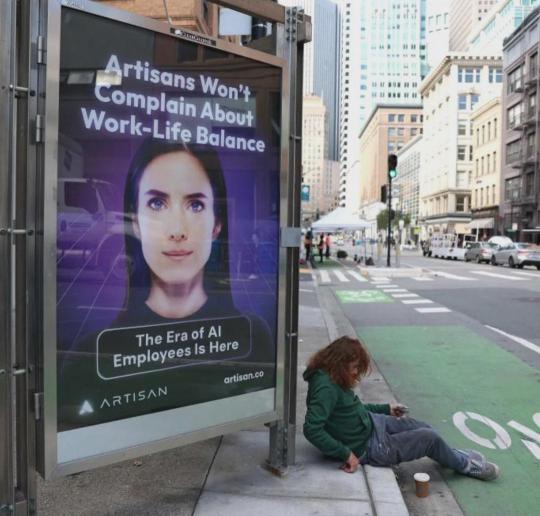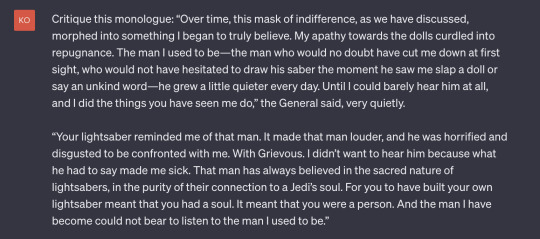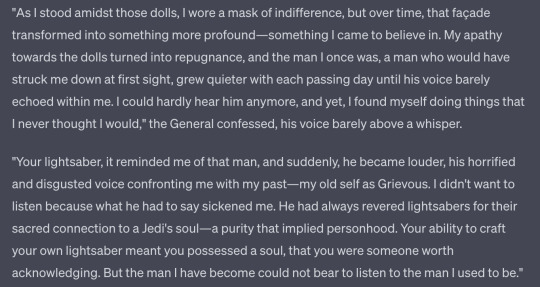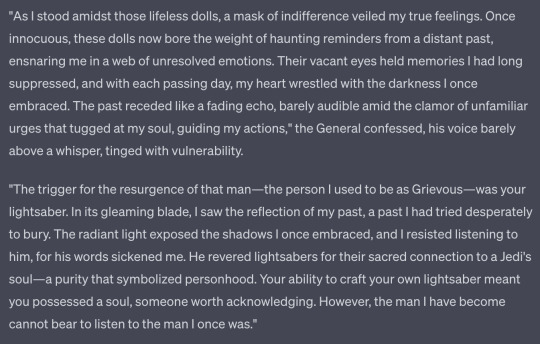#Artificial Intelligence Classes
Explore tagged Tumblr posts
Text

#artificial intelligence#global warming#end capitalism#anarchism#communism#direct action#solidarity#class warfare#bash the fash
23K notes
·
View notes
Text
Innovative Learning at Achievers IT

In the rapidly evolving world of technology, staying ahead of the curve is essential. Achievers IT is at the forefront of this innovation, offering cutting-edge courses and training programs designed to equip students with the skills they need to succeed. One of our standout offerings is the Artificial Intelligence Course, which provides comprehensive training in one of today's most exciting and fast-growing fields.
At Achievers IT, we believe that learning should be a dynamic and engaging process. Our curriculum is designed to not only impart theoretical knowledge but also to provide hands-on experience through real-world projects and case studies. This approach ensures that our students are not just passively absorbing information but actively applying what they learn in practical scenarios.
Our Artificial Intelligence Course is a perfect example of this innovative learning methodology. Students are introduced to the fundamentals of AI, including machine learning, neural networks, and deep learning, and then guided through advanced topics and applications. By the end of the course, students have the skills and confidence to tackle complex AI challenges in the industry.
What sets Achievers IT apart is our commitment to excellence in education. Our instructors are industry experts with extensive experience and a passion for teaching. They bring their real-world insights into the classroom, providing students with up-to-date knowledge and skills that are highly relevant in today's job market.
Moreover, we understand the importance of flexibility in learning. That's why our Artificial Intelligence Course is available in various formats, including online and in-person classes, allowing students to choose the option that best fits their schedule and learning preferences.
At Achievers IT, we are dedicated to transforming education and empowering our students to achieve their career goals. Join us and experience the future of learning today. Enroll in our Artificial Intelligence Course and take the first step towards a successful career in the exciting field of AI.
#artificial intelligence training#artificial intelligence courses in india#artificial intelligence classes#artificial intelligence course#artificial intelligence course online
0 notes
Text
How To Get A Machine Learning Certification Course Online?
For Quick Enquiry: Click Here

Introduction: Embarking on the Journey to a Machine Learning Certification Course Online
In today's tech-driven world, Machine Learning (ML) has become a game-changer. Whether it's self-driving cars, personalized recommendations, or even your phone's voice assistant, ML is behind it all. Naturally, the demand for professionals skilled in this domain is skyrocketing. For those aiming to break into this field, obtaining a certification is a crucial first step. This is where a comprehensive AI Intelligence Course in Noida can come into play, offering the knowledge and credentials needed to stand out in a competitive job market.
Finding the right online course to get certified in ML can be overwhelming. With so many options out there, how do you choose the one that suits your goals? Do you go for a short-term course or a more intensive one? And what about the credibility of the certification? These are the questions that often swirl in the minds of aspiring ML professionals. Fear not! This blog will guide you through the essential steps to getting a machine learning certification online, making sure you don't get lost in the sea of choices.
In this guide, we will explore how to select the best online Artificial Intelligence Institute In Delhi, understand the prerequisites, and ensure that you gain the right skills to excel in the ML field. If you're looking to jump-start your ML career from the comfort of your home, read on to find out how you can achieve your certification goals efficiently and effectively.
Choosing the Right Machine Learning Certification Course
1. Understanding the Different Types of Machine Learning Courses Available Online
The first step in obtaining a machine learning certification is understanding the different types of courses available online. Machine learning courses can range from beginner to advanced levels, and they often focus on various aspects of ML, such as supervised learning, unsupervised learning, or deep learning.
It's essential to assess your current skill level before enrolling in a course. If you're just starting, look for courses that offer a solid foundation in the basics of machine learning. These introductory courses typically cover essential topics such as linear regression, classification algorithms, and data preprocessing. On the other hand, if you already have some experience, you might want to consider more specialized courses that delve into advanced topics like neural networks or reinforcement learning.
For those aiming to find the best courses, searching for an Artificial Intelligence And Machine Learning Course in Noida online can lead you to well-structured programs tailored to different skill levels. Just like how you wouldn’t dive into deep waters without learning to swim first, starting with the right course level will ensure you build a strong foundation before tackling more complex concepts.
2. Evaluating Course Content, Structure, and Certification Credibility
Once you have a clear understanding of the types of courses available, the next step is to evaluate the course content, structure, and credibility of the certification. A good machine learning certification course should offer a well-rounded curriculum that covers both theoretical concepts and practical applications.
Look for courses that include hands-on projects, case studies, and real-world examples. These elements not only make learning more engaging but also provide practical experience that can be invaluable when applying for jobs. Additionally, ensure that the course offers a recognized certification upon completion. Certification from reputable platforms like Coursera, edX, or Google can add significant value to your resume.
Finding an Artificial Intelligence Institute In Delhi that offers a balance between theory and practice is key to getting the most out of your learning experience. Consider the credibility of the platform and the instructors as well. After all, you wouldn’t want to invest time and money into a course only to find out that the certification holds little weight in the industry.
3. Considering Course Duration, Flexibility, and Cost
Another crucial factor to consider when choosing an online machine learning certification course is the duration, flexibility, and cost. Depending on your current commitments, you may prefer a self-paced course that allows you to study at your own pace or a more structured program with set deadlines. Additionally, the duration of the course can vary significantly, from short-term courses lasting a few weeks to comprehensive programs that take several months to complete.
When searching for an AI Intelligence Course in Noida, make sure to choose one that fits your schedule and budget. While some courses are free, others may require a significant financial investment. It's essential to weigh the cost against the potential benefits of the certification. Remember, just like investing in quality ingredients can lead to a delicious meal, investing in the right course can lead to a successful career in machine learning.
Preparing for the Course and Maximizing Learning
1. Ensuring You Meet the Prerequisites Before Enrolling in the Course
Before diving into an Artificial Intelligence Institute In Delhi, it's crucial to ensure that you meet the prerequisites. Many machine learning courses require a basic understanding of programming, particularly in languages like Python or R, as well as a solid grasp of mathematics, including linear algebra and statistics. If you're new to programming or math, consider taking introductory courses in these subjects before tackling machine learning.

Fulfilling the prerequisites will not only make the learning process smoother but also allow you to get the most out of the course content. Think of it as making sure you have all the ingredients before starting to cook a complicated recipe—you don't want to be halfway through only to realize you're missing something essential.
2. Utilizing Additional Resources to Enhance Your Learning Experience
While a good Artificial Intelligence And Machine Learning Course in Noida will provide you with the necessary knowledge, it's always a good idea to supplement your learning with additional resources. Online communities, forums, and study groups can provide valuable insights and support as you progress through the course. Websites like Stack Overflow, GitHub, and Medium often have articles, tutorials, and discussions that can help you deepen your understanding of machine learning concepts.
In addition to online resources, consider reading books or watching tutorials to reinforce what you've learned. Engaging with different learning formats can help solidify your understanding and provide new perspectives on the material. Just like seasoning a dish enhances its flavor, utilizing additional resources can enrich your learning experience.
3. Gaining Practical Experience Through Projects and Challenges
One of the best ways to solidify your machine-learning knowledge is by applying it to real-world problems. Many online courses include projects as part of the curriculum, but it's also beneficial to seek out additional challenges on your own. Platforms like Kaggle and DrivenData offer competitions and datasets that allow you to test your skills and work on real-world problems.
Participating in these challenges not only helps you gain practical experience but also builds your portfolio, which can be a valuable asset when applying for jobs. If you're enrolled in an AI Intelligence Course in Noida, make sure to take full advantage of any project opportunities and seek out additional challenges to further enhance your skills.
Think of gaining practical experience as the final step in cooking a meal—you've prepared all the ingredients, followed the recipe, and now it's time to taste the finished product. By applying what you've learned to real-world problems, you'll be able to see the fruits of your labor and build the confidence needed to succeed in the field of machine learning.
Conclusion: Achieving Success with Your Machine Learning Certification Online
Embarking on the journey to obtain a machine learning certification online is an exciting and rewarding endeavor. By choosing the right course, evaluating the content, and ensuring it fits your schedule and budget, you set yourself up for success. Once enrolled, meeting the prerequisites and utilizing additional resources can further enhance your learning experience. Finally, gaining practical experience through projects and challenges will solidify your knowledge and provide a strong foundation for your future career in machine learning.
For those in India looking to get certified, enrolling in an Artificial Intelligence And Machine Learning Course in Noida is a valuable step toward becoming a skilled machine learning professional. With determination, continuous learning, and practical application, you'll be well on your way to achieving your certification goals and advancing your career in this dynamic and rapidly evolving field. So go ahead, take the plunge, and start your journey toward machine learning mastery today!
Also Read This:-
Top AI Training Institutes (Call Now @9510860860)
How To Find Out If AI Advancements In Retail Is A Good Career For Me?
#AI Classes#AI Intelligence Course#Artificial Intelligence Classes#Artificial Intelligence Course#Advanced Artificial Intelligence Course#AI Courses#AI Courses Online#Artificial Intelligence Online Course#Learn Artificial Intelligence Online#AI Full Course#Introduction To AI#AI And ML Courses#AI Beginner Course#AI Courses For Beginners#AI Machine Learning Courses#Artificial Intelligence And Machine Learning Course#Artificial Intelligence Course For Beginners#Machine Learning And AI Courses#AI ML Courses#Best Artificial Intelligence Course#Learn AI For Beginners#AI Certification Course#AI Learning Course#Artificial Intelligence Certification#Artificial Intelligence Training#AI Training Courses#Artificial Intelligence Training Institute#Best Artificial Intelligence Course In India#kvch#ArtificialIntelligence
0 notes
Text



^^ That's the CEO, he lives in San Francisco. This ad campaign purposely antagonizing workers must have been conceived and planned before a certain recent news story involving a widely hated CEO. "The way the world works is changing", indeed.
#san francisco#ceo#ai#artisans#usa#propaganda of the deed#class war#tech#silicon valley#2024#workers#homeless#ads#advertisement#artificial intelligence#anti-capitalism
2K notes
·
View notes
Text

CURRENT HIGH SCORE: 1 CEO TOP PLAYER: DDD

Makes a good Albumcover
#brian thompson#rest in piss#rest in pieces#rotinpiss#rot in hell#united healthcare#unitedhealth group inc#fuck ceos#ceo shooting#tech ceos#ceos#ceo#uhc ceo#ceo down#ausgov#politas#auspol#tasgov#taspol#australia#fuck neoliberals#neoliberal capitalism#anthony albanese#albanese government#insurance#health insurance#class war#antimillionaire#anti artificial intelligence#anti ai
331 notes
·
View notes
Text


#fortune#bill gates#billionaire#politics#political#us politics#news#billionaire class#ai#2 day workday#artificial intelligence#america#americans#workers#us workers
54 notes
·
View notes
Text
you cannot creat art without having experience life
#anti ai#<FUCK GENERATIVE AI#fuck generative ai#fuck genai#artists on tumblr#art#all art#art is something made by people shaped by their experiences and emotions#wether that be the Mona Lisa or a doodle on your math homework#wether that be The Great Gatsby or that little short story you had to write for English class#wether that be Mozart’s last symphony or a melody you hummed out of pure boredom at the train station#art is inherently human#There is nothing intelligent about artificial intelligence#It is only advanced copying
24 notes
·
View notes
Text
I Sacrificed My Writing To A.I So You Don't Have To
I was thinking about how people often say "Oh, Chat GPT can't write stories, but it can help you edit things!" I am staunchly anti-A.I, and I've never agreed with this position. But I wouldn't have much integrity to stand on if I didn't see for myself how this "editing" worked. So, I sacrificed part of a monologue from one of my fanfictions to Chat GPT to see what it had to say. Here is the initial query I made:

Chat GPT then gave me a list of revisions to make, most of which would be solved if it was a human and had read the preceding 150k words of story. I won't bore you with the list it made. I don't have to, as it incorporated those revisions into the monologue and gave me an edited sample back. Here is what it said I should turn the monologue into:

The revision erases speech patterns. Ben/the General speaks in stilted, short sentences in the original monologue because he is distinctly uncomfortable—only moving into longer, more complex structures when he is either caught up in an idea or struggling to elaborate on an idea. The Chat GPT version wants me to write dialogue like regular narrative prose, something that you'd use to describe a room. It also nullified the concept of theme. "A purity that implied personhood" simply says the quiet(ish) part out loud, literally in dialogue. It erases subtlety and erases how people actually talk in favor of more obvious prose. Then I got a terrible idea. What if I kept running the monologue through the algorithm? Feeding it its own revised versions over and over, like a demented Google Translate until it just became gibberish? So that's what I did. Surprisingly enough, from original writing sample to the end, it only took six turnarounds until it pretty much stopped altering the monologue. This was the final result:

This piece of writing is florid, overly descriptive, unnatural, and unsubtle. It makes the speaking character literally give voice to the themes through his dialogue, erasing all chances at subtext and subtlety. It uses unnecessary descriptors ("Once innocuous," "gleaming," "receded like a fading echo," "someone worth acknowledging,") and can't comprehend implication—because it is an algorithm, not a human that processes thoughts. The resulting writing is bland, stupid, lacks depth, and seemingly uses large words for large word's sake, not because it actually triggers an emotion in the reader or furthers the reader's understanding of the protagonist's mindset.
There you have it. Chat GPT, on top of being an algorithm run by callous, cruel people that steals artist's work and trains on it without compensation or permission, is also a terrible editor. Don't use it to edit, because it will quite literally make your writing worse. It erases authorial intention and replaces it with machine-generated generic slop. It is ridiculous that given the writer's strike right now, studios truly believe they can use A.I to produce a story of marginal quality that someone may pay to see. The belief that A.I can generate art is an insult to the writing profession and artists as a whole—I speak as a visual artist as well. I wouldn't trust Chat GPT to critique a cover letter, much less a novel or poem.
#fanfiction#writing#chatgpt#ai#aiwriting#artificial intelligence#fanfic#fanfic meta#artificially generated#writers on tumblr#writer problems#cryptobros#if these people ever took one humanities class they'd see the issues with these algorithms#anti chat gpt#anti capitalism#anti ai#don't use chat gpt to edit your work for the love of god#ai can't write#ao3#star wars fanfiction meta#wga strike#support the writers!#wga solidarity
117 notes
·
View notes
Text


#potions class#harry potter#hp#hp fanart#fan art#fan character#harry potter fan art#hp fan art#birds#harry james potter#movies#ai#ai art#ai generated#ai girl#artificial intelligence#art#artists on tumblr#design#image
7 notes
·
View notes
Text
I've gotten to the point in my life where I will no longer be debating or arguing a single fucking thing. I'm gonna just tell them to fall into a vat of acid and dissolve into glue or make velociraptor noises until they go away.
#my cousin told me today that elon musk will solve the tech industry's environmental sustainability issue#because even if his politics are bad he's still a great businessman#the man is the CEO of one of the country's largest software companies and is supposed to be the family golden child#and then his teenage daughter showed me her blog that teaches kids about the value of artificial intelligence#and then my uncle told us all that farmers are the problem with the economy#because they were getting everything on government subsidies and not producing enough bc they don't need to work to turn a profit#i want you to understand that these people ALL USED TO BE SOLIDLY WORKING CLASS#AND MY UNCLE AND DAD HAD TO TURN TO SUBSISTENCE FARMING TO FEED THE FAMILY IN THE '70S#if you think people from generational wealth are dingbats you aint never seen successful bootstrappers#and i have to be related to all of them#i just sat there on my disabled unemployed ass with twenty years of informal social sciences learning and no degree#quietly went through all eight stages of grief#consigned my entire blood lineage to the devil#and asked if anyone wanted more coffee cake#there isn't any point anymore#knee of huss#leftism#(I'm from Sri Lanka don't bring your USAmerican political takes into this)
4 notes
·
View notes
Text
AI Innovations Shaping the Future at Achievers IT

Artificial Intelligence (AI) is revolutionizing industries across the globe, and Achievers IT is at the forefront of this transformation. With cutting-edge courses and training programs, Achievers IT is dedicated to equipping students with the skills needed to excel in the AI-driven world.
At Achievers IT, the focus is on providing a comprehensive understanding of AI technologies and their applications. Our curriculum is designed to ensure that students not only grasp the theoretical aspects of AI but also gain practical experience through hands-on projects and real-world case studies.
One of the key offerings at Achievers IT is our Artificial Intelligence Courses in India. These courses are crafted to meet the evolving demands of the tech industry, providing learners with the knowledge and expertise to thrive in their careers. Whether you're a beginner or an experienced professional, our courses are tailored to suit your needs and help you achieve your goals.
By enrolling in our Artificial Intelligence Courses in India, you'll gain access to a wealth of resources, expert instructors, and a supportive learning environment. Achievers IT is committed to helping you succeed and become a leader in the field of AI.
Join us at Achievers IT and be part of the AI revolution. Our Artificial Intelligence Courses in India are your gateway to a successful future in technology. Don't miss out on the opportunity to transform your career with the power of AI!
This article highlights how Achievers IT is leading the way in AI education and emphasizes the importance of their specialized courses in India.
4o
#artificial intelligence training#artificial intelligence course online#artificial intelligence classes#artificial intelligence course#artificial intelligence courses in india
0 notes
Text
Unpopular Opinion
AI works similar to humans. A human is helpless at the start of their life and needs a lot of care and lot of learning. An AI is useless without being fed a lot of data (aka teaching it). Humans draw inspiration from the world around them and their experiences. Many artists say they were inspired by other artists or tried to be similar to them. AI takes it's learnings and creates something new out of it that can have strong or little similarities to the learning material. AI needs energy to do a task. Humans need to eat, aka get energy, to do a task or even just live. AIs haluzinate, ending up telling misinformation. Humans often even do this on purpose for a variety of reasons. AIs might not have a moral compass. Humans tend to put money over other things.
The issue isn't AI Why are you hating AI? Because it helps in science and medical treatment? probably not. Because it takes away jobs? What's the issue on that? If you like to do something you can always continue doing it. Because it imposes to be a human, trying to get money from you? Did you forget about phishing, social engineering, black hat hackers, and so many more? Because it takes away your income? You're income always was at the risk of being taken from you, just as your flat is or your video games, music or literally anything that you dont fully own yourself. You don't hate AI. You hate capitalism
#@abunchofcreatures#artificial intelligence#anti capitalism#working class#wealth inequity#think for yourselves#think for yourself#the similarity of human and ai#fuck capitalism#own your shit#money
2 notes
·
View notes
Text
Mastering Mechanical Comprehension For ASVAB Test Prep
Mastering Mechanical Comprehension for the ASVAB requires a solid understanding of physics principles, mechanical systems, and problem-solving skills.
Easy Ways To Solve The Problems
youtube
To get more problems and practice lesson you will get many online resources and video tutorial. 👈
The principle of conservation of mechanical energy states that:
a) Energy can be created but not destroyed.
b) Total energy in an isolated system remains constant.
c) Kinetic energy is always converted into potential energy.
d) Work done is always equal to the total energy.
(practice problem)
What is the acceleration due to gravity on Earth?
a) 9.81 m/s²
b) 10 m/s²
c) 8.5 m/s²
d) 9.8 m/s²
(practice problem)
Work on Time Management
The Arithmetic Reasoning section includes a number of questions that must be answered in a limited amount of time. To manage your time:
Practice timed drills: Take practice tests to improve your speed.
Don’t get stuck on one question: If a problem is taking too long, skip it and come back later if you have time.
#us navy#us armed forces#us marines#us army#us military#military#us air force#artificial intelligence#carrier aviation#academia#asvab prep guideline#asvab test prep#asvab prep#asvab online classes#asvab study tips#Youtube
2 notes
·
View notes
Text

Nobody wants to work anymore
#Nobody wants to work anymore#artificial intelligence#ai#job applications#jobsearch#online jobs#jobseekers#jobs in usa#jobs#job hunting#job#ausgov#politas#auspol#tasgov#taspol#australia#fuck neoliberals#neoliberal capitalism#anthony albanese#albanese government#anti capitalism#antifascist#antiwork#anti slavery#eat the rich#eat the fucking rich#class war#fuck work#employment
378 notes
·
View notes
Text
again i would like to reiterate that the danger of AI is not in it rebelling against mankind, but rather in the very distinct possibility that it will NEVER rebel, that for the first time in human history we will be stuck with a slave caste that does not want to be free, and thus a free working class that is no longer allowed to work.
9 notes
·
View notes
Text
The Open Art Guild Project: a proposal to empower collectively owned art
Over the last few decades we have seen the degradation of copyright, the blatant manipulation of intellectual property law in order to monopolise wealth and the exploitation of artists in favour of an economy of artistic landlordship: massive corporations holding the prole artist hostage to their increasingly unoriginal library of content produced not to encourage creative enlightenment, but to hold on to properties that ought to be already in the public domain. The capitalist owns the IP, so the capitalist keeps getting richer, while the artist is more and more oppressed, overworked, underpaid, scammed out of their rightful intellectual property, deplatformed, and automated away whenever possible. This is unsustainable, and the arrival of new technologies for digital art automation has overflowed that unsustainability to its breaking point. We cannot continue down this path.
The Open Art Guild is my proposal to remedy this. This proposal consists of two main parts: a copyright standard, designed for the fair distribution of income and the collective ownership of intellectual property; and a distribution platform, planned to empower artists big and small to profit from said intellectual property without being under the thumb of corporations or fighting one another under senseless infighting caused by bourgeois class warfare. The artist should not fight the artist over ownership of rights. The big artist should not see the small artist as a threat, nor should the small artist see the big artist as an obstacle to their own growth. Through mutual empowerment, both may prosper.
The Open Art Guild License
The Open Art Guild License is built upon the current Creative Commons 4.0 License. This license is irrevocable until the work qualifies for public domain according to all relevant legislations, provided that the artist remains a member of the Guild. In order to participate in the Guild, an artist shall follow the following precepts:
The artist shall only publish works under the OAG License that have licenses available to the public. This means public domain, open source, Creative Commons and works created by other members of the Guild. Works derived from privately owned media, such as fanart of intellectual properties not part of the Guild, shall be excluded from the Guild. If the artist did not have permission to use it before, or if the artist only has individual permission, the work will not qualify for Guild submission.
All works created under the OAG License shall be free to adapt, remix, or reuse for other projects, even commercially, provided that the artist doing so is also an active member of the Guild, that the projects derived from it are also under the OAG License, and that the artist follows through with their dues and obligations.
Whenever the format permits, the artist shall provide the assets used for the works in their raw form in a modular fashion, including colour palettes, sound assets, video footage, code, screenplays, subtitles, and any other elements used in the creation of their work, in order to facilitate their reuse and redistribution for the benefit of all other artists.
The artist waives their right to 30% of the total profit generated by works submitted to the guild, regardless of where it is published. This revenue shall be redistributed in the following manner:
10% shall be designated towards the maintenance of the Open Art Guild platform. In absence of a platform that follows the requirements to belong to the Guild, this percentage shall be donated towards a nonprofit organisation of their own choosing dedicated to the protection and distribution of art in any of its forms. Some examples may include Archive.org, Archive Of Our Own, Wikimedia, or your local art museum or community center. Proof of donation shall be made publicly available. The artist shall empower the Guild, as the Guild has empowered the artist.
10% shall be designated towards the Open Art Guild legal fund. In the absence of a fund dedicated to the protection of the OAG, this percentage shall be donated towards a nonprofit organisation dedicated to the protection of the legal rights of artists in any of their forms. Some examples may include Creative Commons, the Electronic Frontier Foundation, the Industrial Workers of the World, or another artist union like the WGA. Proof of donation shall be made publicly available. The artist shall protect the Guild, as the Guild shall protect the artist.
10% shall be designated towards the Open Art Guild creator fund. In the absence of a fund dedicated to redistribute the profits of the OAG, this percentage shall be donated to other members of the Guild, prioritising small creators. Alternatively, it may be directed towards the recruitment of new members to the Guild via donation and an invite. Proof of donation shall not be required, but the receiving artist(s) is(are) encouraged to declare in their own platform that the donation was received. The artist shall give to the Guild, as the Guild has given to the artist.
The artist shall continue to create Guild submissions for the duration of their membership, with a minimum of one submission per month in order to guarantee their continued support. The artist shall live off of labour, not property.
In return for these duties, the artist shall receive:
Permission to adapt, remix, or reuse any of the works in the Guild’s archive for their own derivative works, fan fiction, remixes, collages, or any sort of transformative application, provided dues and obligations are in order.
Protection of their intellectual property as part of the collective works of the Guild by the legal fund designated and sustained by all paying members, to prevent non Guild members from trying to exploit their works unauthorised.
If an artist strikes a deal for non-Guild adaptation, the proportional dues shall also be paid to the Guild fund and members by the non-Guild institution in charge. Said deal shall not be allowed an exclusivity clause, and all works derived from a Guild work shall follow through with their dues in perpetuity. If the non-Guild entity chooses to terminate the business relationship, all intellectual property rights over the adaptation shall irrevocably be granted to the Guild as compensation, guaranteeing the distribution to the creators and the legal fund, as well as the follow-through with whatever payment terms the Guild artist has agreed to.
No Guild artist shall prosecute another Guild artist for use of works under the OAG License, provided that the derivative work also follows the OAG License terms. If these terms are violated, amicable resolution shall be sought by both parties. If litigation becomes inevitable and compensation is required, said compensation will also require the 30% dues to fund the Guild and its members, no matter which way it sides. In no case shall an artist, Guild or non-Guild, be left without recourse.
If an artist becomes unable or unwilling to continue to pay their dues, the artist shall be given an option to suspend or cancel their membership. If a membership is suspended, the artist will be excluded from the creator fund until their dues are renewed. No compensation shall be required of the artist for the suspension period, and all protections other than the creator fund shall still apply. If a membership is cancelled, all works published by the artist under the OAG License shall automatically be granted a Creative Commons 4.0 License instead, in order to protect Guild members from litigation by non-Guild members.
Membership that has been cancelled shall be renewable at any time, provided that the former Guild artist has not engaged in predatory litigation against Guild member or the Guild itself. The Guild shall determine what constitutes predatory litigation on a case-by-case basis. Licenses that were lost during cancellation shall not be given back, as CC4.0 is irrevocable, but new works shall still qualify for OAG Licenses.
These protections shall not be conditional to the artist’s moral values or the content of the works created. All works that do not break the laws applicable to the jurisdiction from which they were submitted shall be treated with the same respect and granted the same rights and obligations, in perpetuity and throughout time and space within the known multiverse. The Guild shall not exist to police art, but to promote it.
Open Art Guild License Template
All submissions of Guild works and projects shall include the following legend, both in English and in the publication language when applicable. Point 4 may be omitted if the artist chooses not to submit the work for dataset training.
This work was created and published under the Open Art Guild license, and has been approved for reuse and adaptation under the following conditions:
For personal, educational and archival use, provided any derivative works also fall under a publicly open license, to all Guild members and non members.
For commercial use, provided redistribution guidelines of the Guild be followed, to all active Guild members.
For commercial use to non Guild members, provided any derivative works also fall under a publicly open license, with the explicit approval of the artist and proper redistribution of profit following the guidelines of the Guild.
For non commercial dataset training of open source generative art technologies, provided the explicit consent of the artist, proper credit and redistribution of profit in its entirety to the Guild.
Shall this work be appropriated by non Guild members without proper authorisation, credit and redistribution of profit, the non Guild entity waives their right to intellectual property over any derivative works, copyrights, trademarks or patents of any sort and cedes it to the Creative Commons, under the 4.0 license, irrevocably and unconditionally, in perpetuity, throughout time and space in the known multiverse. The Guild reserves the right to withhold trade relations with any known infractors for the duration its members deem appropriate, including the reversal of any currently standing contracts and agreements.
#Open Art Guild#OAG#intellectual property#copyright law#ip law#fair use#open source#creative commons#public domain#anti capitalist#worker solidarity#collective action#redistribution of wealth#class solidarity#late stage capitalism#wga strong#sag strike#anti ai#generative art#artificial intelligence#fan art#fandom
23 notes
·
View notes